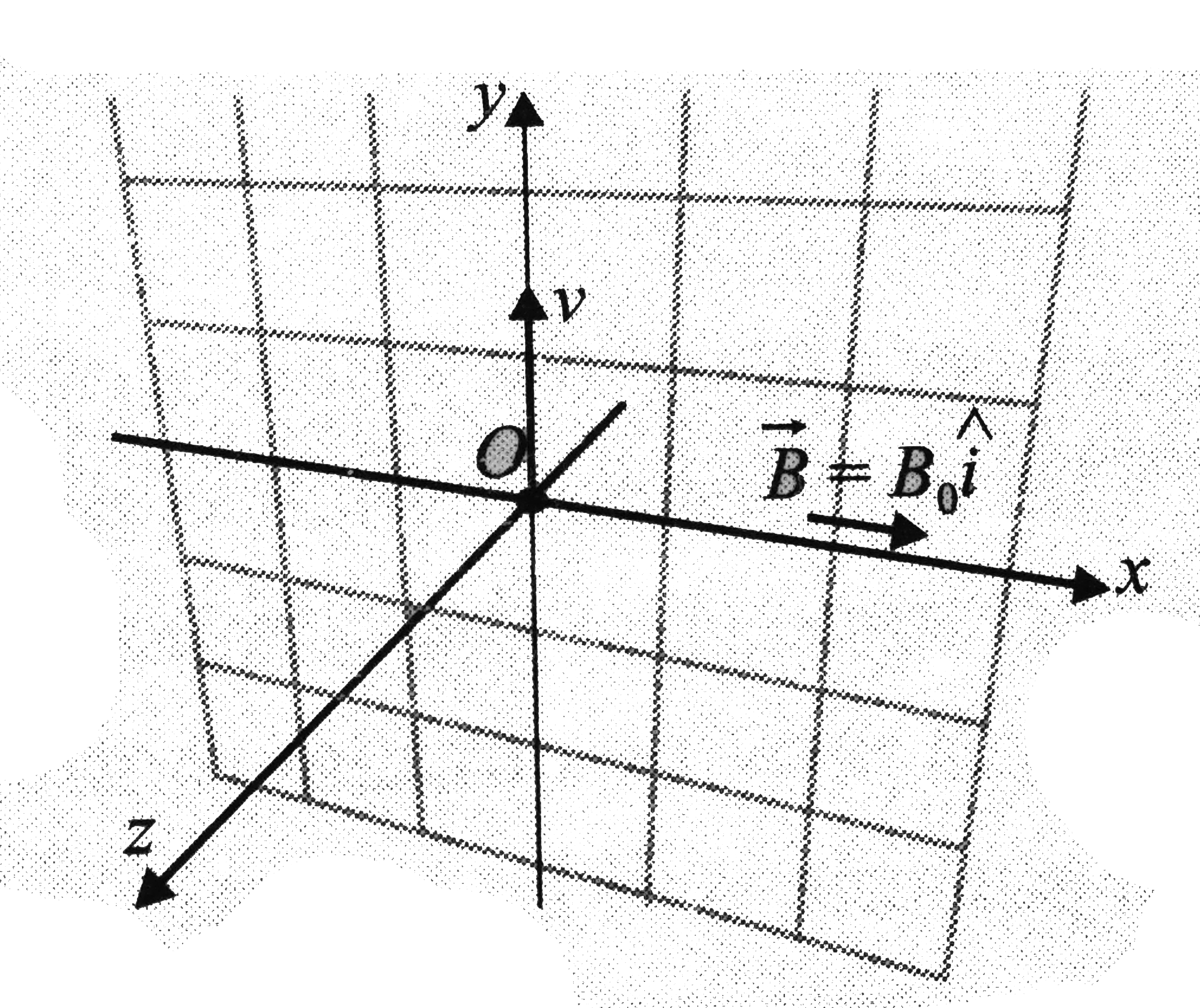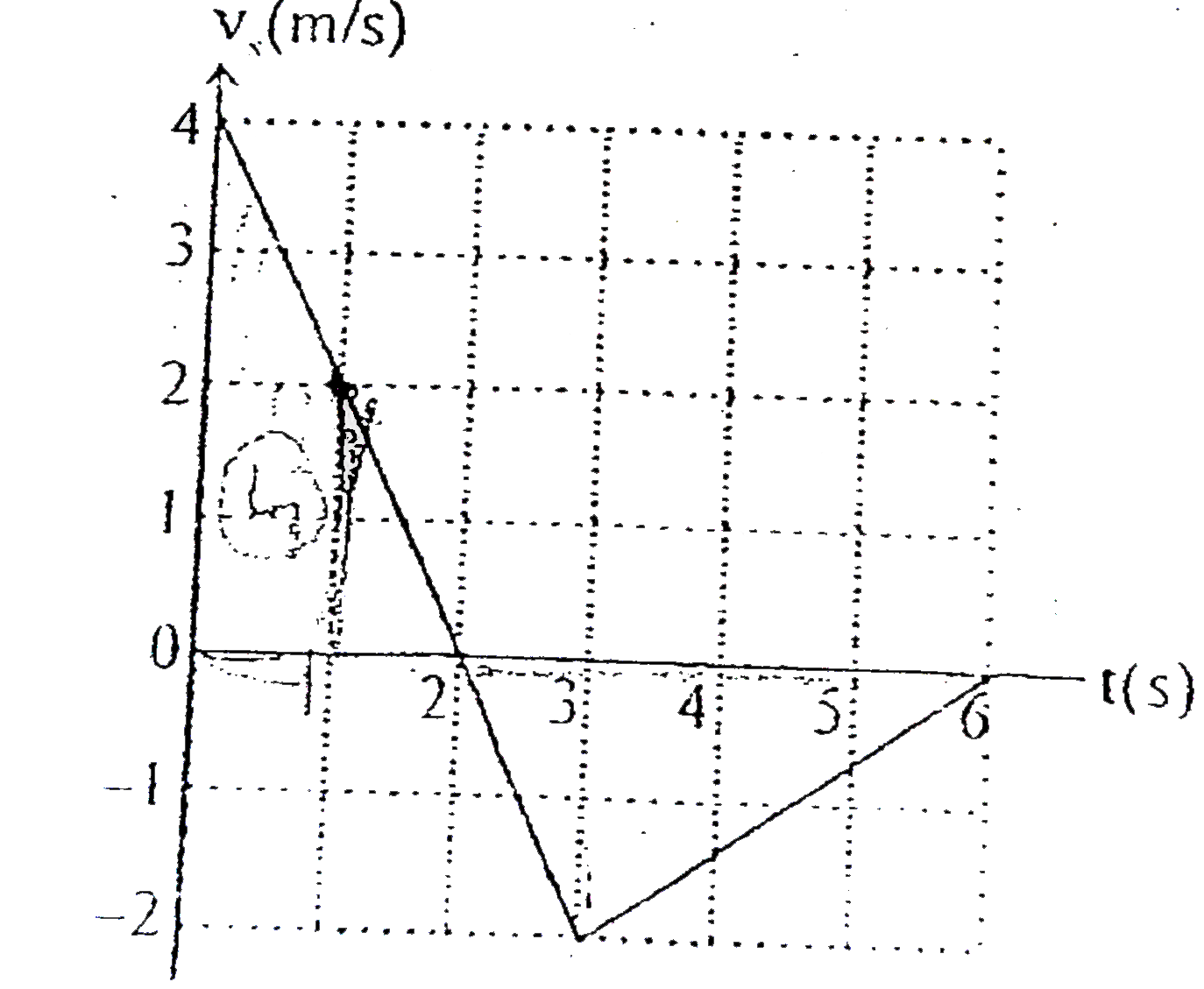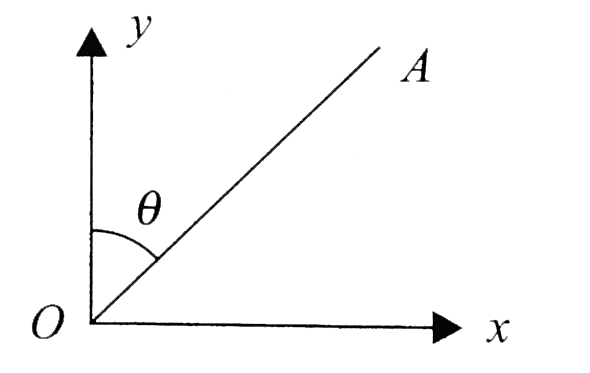There exist uniform magnetic and electric fields of manitudes 1T and 1Vm−1 respectively, along positive y-axis. A charged particle of mass 1kg and charge 1C is having velocity 1ms−1 along x-axis and is at origin at t=0. Then, the coordinates of the particle at time πs will be
(0,1,2)
(0,−π2/2,−2)
(2,π2/2,2)
(0,π2/2,2)
The correct Answer is:D
To solve the problem, we need to analyze the motion of a charged particle in the presence of uniform electric and magnetic fields. Here are the steps to find the coordinates of the particle at time t=π seconds.
1. Identify the Given Data:
- Mass of the particle, m=1kg
- Charge of the particle, q=1C
- Velocity of the particle, v=1m/s along the x-axis
- Electric field, E=1V/m along the y-axis
- Magnetic field, B=1T along the y-axis
2. Determine the Forces Acting on the Particle:
- The force due to the electric field is given by:
FE=qE=1C×1V/m=1N
- The magnetic force is given by:
FB=q(→v×→B)
Since the velocity is along the x-axis and the magnetic field is along the y-axis, the magnetic force will act along the z-axis:
FB=1C×(1m/s×1T)=1N (in the z-direction)
3. Calculate the Acceleration:
- The total force acting on the particle is:
Ftotal=FE+FB=1N(y-direction)+1N(z-direction)
- The acceleration due to the electric field is:
a=FEm=1N1kg=1m/s2 (in the y-direction)
- The acceleration due to the magnetic field does not contribute to the motion in the y-direction, but it causes circular motion in the x-z plane.
4. Determine the Radius of Circular Motion:
- The radius R of the circular motion can be calculated using:
R=mvqB=1kg×1m/s1C×1T=1m
5. Calculate the Time Period:
- The time period T of the circular motion is given by:
T=2πmqB=2π×1kg1C×1T=2πs
6. Determine the Position at t=π seconds:
- At t=π seconds, the particle completes half of its circular path (since π seconds is half of the time period 2π seconds).
- The coordinates in the x-z plane after half a rotation will be:
- x=0 (since it moves from (1,0) to (0,1))
- z=1 (it moves up in the z-direction)
- The y-coordinate due to the electric field after π seconds is calculated using:
y=ut+12at2=0+12⋅1m/s2⋅(π)2=π22
7. Final Coordinates:
- Therefore, the coordinates of the particle at t=π seconds are:
(x,y,z)=(0,π22,1)
Final Answer:
The coordinates of the particle at time t=π seconds are:
(0,π22,1)
- Mass of the particle, m=1kg
- Charge of the particle, q=1C
- Velocity of the particle, v=1m/s along the x-axis
- Electric field, E=1V/m along the y-axis
- Magnetic field, B=1T along the y-axis
- The force due to the electric field is given by:
FE=qE=1C×1V/m=1N
- The magnetic force is given by:
FB=q(→v×→B)
Since the velocity is along the x-axis and the magnetic field is along the y-axis, the magnetic force will act along the z-axis:
FB=1C×(1m/s×1T)=1N (in the z-direction)
- The total force acting on the particle is:
Ftotal=FE+FB=1N(y-direction)+1N(z-direction)
- The acceleration due to the electric field is:
a=FEm=1N1kg=1m/s2 (in the y-direction)
- The acceleration due to the magnetic field does not contribute to the motion in the y-direction, but it causes circular motion in the x-z plane.
- The radius R of the circular motion can be calculated using:
R=mvqB=1kg×1m/s1C×1T=1m
- The time period T of the circular motion is given by:
T=2πmqB=2π×1kg1C×1T=2πs
- At t=π seconds, the particle completes half of its circular path (since π seconds is half of the time period 2π seconds).
- The coordinates in the x-z plane after half a rotation will be:
- x=0 (since it moves from (1,0) to (0,1))
- z=1 (it moves up in the z-direction)
- The y-coordinate due to the electric field after π seconds is calculated using:
y=ut+12at2=0+12⋅1m/s2⋅(π)2=π22
- Therefore, the coordinates of the particle at t=π seconds are:
(x,y,z)=(0,π22,1)
The coordinates of the particle at time t=π seconds are:
(0,π22,1)
Topper's Solved these Questions
- ELECTRODYNAMICSBOOK - RESONANCE ENGLISHCHAPTER - ELECTRODYNAMICSEXERCISE - Exercise-2 PART-2
26 Videos
- ELECTRODYNAMICSBOOK - RESONANCE ENGLISHCHAPTER - ELECTRODYNAMICSEXERCISE - Exercise-2 PART-3
18 Videos
- ELECTRODYNAMICSBOOK - RESONANCE ENGLISHCHAPTER - ELECTRODYNAMICSEXERCISE - Exercise-1 PART-2
54 Videos
- ELECTRO MAGNETIC WAVESBOOK - RESONANCE ENGLISHCHAPTER - ELECTRO MAGNETIC WAVESEXERCISE - Exercise 3
27 Videos
- ELECTROMAGNETIC INDUCTIONBOOK - RESONANCE ENGLISHCHAPTER - ELECTROMAGNETIC INDUCTIONEXERCISE - A.l.P
19 Videos
Similar Questions
A charge particle of mass m and charge q is projected with velocity v along y-axis at t=0.

Find the velocity vector and position vector of the particle →v(t)and→r(t) in relation with time.
View SolutionIn a certain region of space, there exists a uniform and constant electric field of magnitude E along the positive y-axis of a coordinate system. A charged particle of mass m and charge -q (qgt0) is projected form the origin with speed 2v at an angle of 60∘ with the positive x-axis in x-y plane. When the x-coordinate of particle becomes √3mv2/qE a uniform and constant magnetic. field of strength B is also switched on along positive y-axis.
x-coordinate of the particle as a function of time after the magnetic field is switched on is
View SolutionIn a certain region of space, there exists a uniform and constant electric field of magnitude E along the positive y-axis of a coordinate system. A charged particle of mass m and charge -q (qgt0) is projected form the origin with speed 2v at an angle of 60∘ with the positive x-axis in x-y plane. When the x-coordinate of particle becomes √3mv2/qE a uniform and constant magnetic field of strength B is also switched on along positive y-axis.
Velocity of the particle just before the magnetic field is switched on is
View SolutionThe magnetic field exists along negative x-axis and electric field exists along positive x-axis. A charged particle moves with a velocity inclined at an angle (θ) with vertical in (x-y) plane. What will be the correct diagram of the helical path?
View SolutionIn a certain region of space, there exists a uniform and constant electric field of strength E along x-axis and uniform constant magnetic field of induction B along z-axis. A charge particle having charge q and mass m is projected with speed v parallel to x-axis from a point (a, b, 0). When the particle reaches a point( 2a, b/2, 0) its speed becomes 2v. Find the value of electric field strength in term of m, v and co-ordinates.
View SolutionA time varying force, F=2t is acting on a particle of mass 2kg moving along x-axis. velocity of the particle is 4m/s along negative x-axis at time t=0. Find the velocity of the particle at the end of 4s.
View SolutionUniform electric field E and magnetic field B, respectively, are along y-axis as shown in the figure. A particle with specific charge q/m leaves the origin O in the direction of x-axis with an initial non-relativistic speed v0.Thec∞rd∈ateY_(n) of the particle when it crosses the y-axis for the nth time is:
View SolutionVx is the velocity of a particle of a particle moving along the x−axis as shown. If x=2.0m at t=1.0s, what is the position of the particle at t=6.0s?

View SolutionA particle of mass 2 kg charge 1 mC is projected vertially with velocity k10ms−1. There is as uniform horizontal electric field of 104N/C, then
View SolutionA uniform magnetic field B and electric field E exist along y and negative z axis respectively. Under the influence of these field a charge particle moves along OA undeflected. If electric field is switched off, find the pitch of helical trajectory in which the particle will move.

View Solution